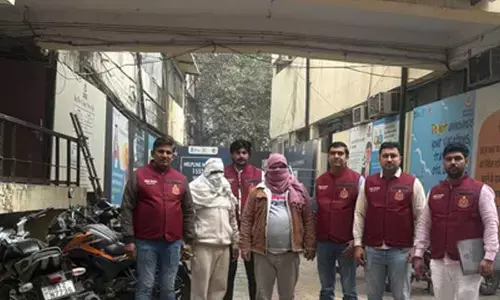Pacific approach to deal with the dual burden of TB-diabetes

Pacific Approach To Deal With The Dual Burden Of TB-Diabetes.Many of the 22 countries that comprise the Pacific Islands region have very high rates of type-2 diabetes..
Many of the 22 countries that comprise the Pacific Islands region have very high rates of type-2 diabetes (upto 37% prevalence in adults) and high rates of TB as well (upto 343 cases per 100000). In fact 7 of the world’s top 10 countries with the highest prevalence of diabetes are in the Pacific Islands region: Tokelau, Marshall Islands, Vanuatu, Cook Island, Nauru, Micronesia and Kiribati. Similarly, some countries also have very high TB rates. It is no wonder then that the problem of TB-diabetes co-morbidity afflicts this region as well.
 During the ongoing 5th Asia Pacific Region Conference on Lung Health of the International Union Against Tuberculosis and Lung Disease (The Union) in Sydney, Dr Richard Brostrom, State TB Branch Chief and Pacific Regional Medical Officer, Centers for Disease Control and Prevention (CDC), spoke to CNS about his team’s innovative and integrated approach to deal with this dual burden.
During the ongoing 5th Asia Pacific Region Conference on Lung Health of the International Union Against Tuberculosis and Lung Disease (The Union) in Sydney, Dr Richard Brostrom, State TB Branch Chief and Pacific Regional Medical Officer, Centers for Disease Control and Prevention (CDC), spoke to CNS about his team’s innovative and integrated approach to deal with this dual burden.One patient with two diseases!
According to Brostrom, "TB-diabetes co-morbidity is a global problem, but we in the Pacific region, see it as a local problem and approach it from the patient’s perspective - it is about one patient with two diseases. Rather than divide the care, we try to integrate the care for each patient. Once we started doing a blood glucose test for every adult TB patient the number of TB patients with diabetes became very high. It is known now that 60% of the adult Pacific islanders with TB also have diabetes. And many of them are unaware of their diabetes status when they first come to a TB clinic."
So this is a unique region where a majority of patients with active TB also have diabetes.
"This does not give us the luxury of building a special programme to deal with this problem but instead integrate TB and diabetes care. We not only check for diabetes in all our TB patients but also try to check for TB in diabetes clinics. This serves two purposes - find TB cases that are in a diabetes clinic and get an opportunity for prevention of TB. People with diabetes are a high-risk group for TB and so it makes sense to test them for latent TB infection and then give them preventive medicine so that they do not reach active TB stage. There is a list of special interventions for our clinicians to remind them that people with diabetes may have special needs - medication doses might have to be adjusted for those TB-diabetes patients who have kidney problem; we also have to look for drug resistance, as more and more drug resistance is associated with diabetes patients. Then again, we know that in people with diabetes, TB relapse rates are 3-4 times higher than in TB patients without diabetes. So in the Pacific, we very often treat TB patients with diabetes for 9 months, instead of the normal 6 months, to prevent relapse," said Dr Brostrom.
Dr Brostrom and his team have trained their TB clinic staff to manage diabetes, in order to maximize quality of care and improve TB treatment outcomes. The DOTS providers, community workers and nurses have been given basic diabetes education. With help from Australian Respiratory Council a flipchart of diabetes education has been developed to go along with TB education. A TB healthcare provider makes 100 home visits of a TB patient during his/her TB treatment period. It is during these regular face-to-face interactions that the patients are told on how to manage their diabetes, along with ensuring that they are swallowing their TB drugs.
"This has really helped in reducing the patients' glucose levels. As long as they are under TB treatment, we provide them with long lasting information for keeping their diabetes under control. This repeated teaching is done not only of the patients, but also of their family members. Messages are simple and repeated. Our TB nurses do not talk about diabetes medication, but they are competent to advice about the benefits of optimum food portion sizes, substituting carbohydrates with vegetables, and exercising. A typical TB patient with diabetes has very little understanding about diabetes and its risk factors. So this education really helps. When the patients get a chance to sit down with a nurse in their living room or kitchen, who not only gives them their TB medicine but talks about their diabetes too, it makes the whole issue more humane," feels Dr Brostrom.
It is perhaps because of this reason that, unlike the bigger countries, in the Pacific region, often the problem of adherence is less acute. Also as the population is small - most islands have 30,000-40,000 inhabitants - it becomes difficult for TB patients to escape the DOTS providers who do a good job of follow up. No wonder treatment success rates are as high as 90%-95% in some places, as shared by Dr Brostrom.
"We do not aim to change the diabetes incidence through a TB programme. But we do want to address how diabetes affects TB patients in not only the Pacific but also in other parts of the world," he said.
Is TB-stigma a barrier for TB testing in diabetes clinics?
Ms Kerri Viney, Research Fellow at Australian National University and a TB Consultant shared similar thoughts with Citizen News Service (CNS): "Diabetes has been slowly increasing in this region, as across the world, to the point that it has become a major health problem. We have been talking about the TB-diabetes co-morbidity problem close to about 10 years, but it was only in 2008-2009 that we realized its seriousness. Bidirectional screening is part of the collaborative framework for TB-diabetes care and many countries like Fiji, Kiribati, Marshall Islands, and Micronesia are screening TB patients for diabetes. But the harder part is getting diabetes patients screened for TB. This could partly be due to the stigma attached with TB and also because screening for diabetes can be done easily in a TB clinic, but to test for TB is more complex”.
Common risk factors: obesity and tobacco!
According to Dr Brostrom obesity and tobacco are common risk factors for TB and diabetes. Other risk factors would include an unhealthy diet. "This is sort of a suicidal risk factor at this point of time with food insecurity, poverty, poor food choices that are available. It is expensive to eat well and diabetes has now become a disease of the poor because of food insecurity," he said.
Meanwhile, Kerri feels that it is necessary to scale up TB-diabetes collaborative care and not just bidirectional screening. There is need for more data on TB prevalence in patients with diabetes and also more information about the dynamics of the two diseases. She thinks that as it might be an uphill task to screen all diabetes patients for TB, perhaps one may screen those with uncontrolled blood sugar or those on insulin. Another point to ponder upon is about TB prevention in people with diabetes.
Dr Brostrom strongly feels that having successfully integrated TB-diabetes care and control, the next step forward would be to integrate tobacco control with the DOTS programme. But this would not be easy. He cautions that it would be a much tougher job to get someone quit smoking or change his or her dietary habits as compared to completing TB treatment. Yet, it is high time that tobacco control becomes an important component of the collaborative efforts to tackle TB and diabetes.
By Shobha Shukla
Next Story

















